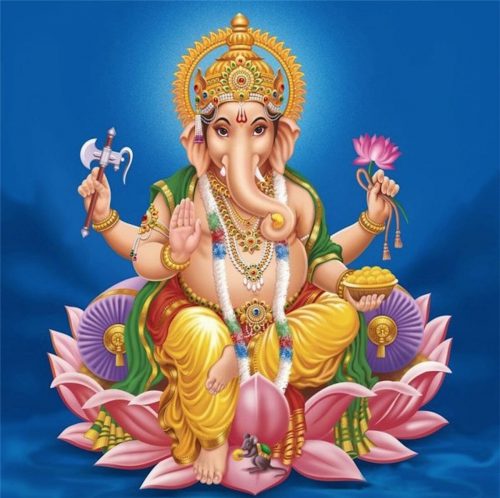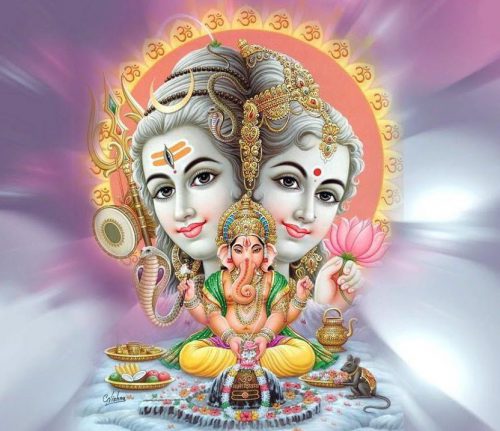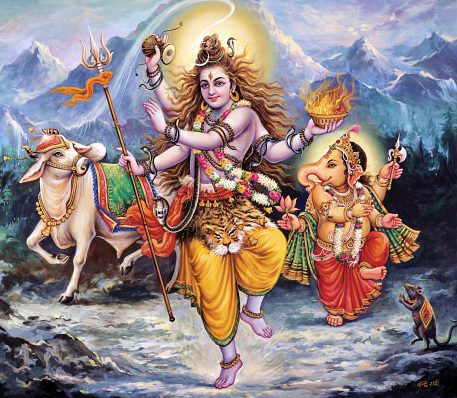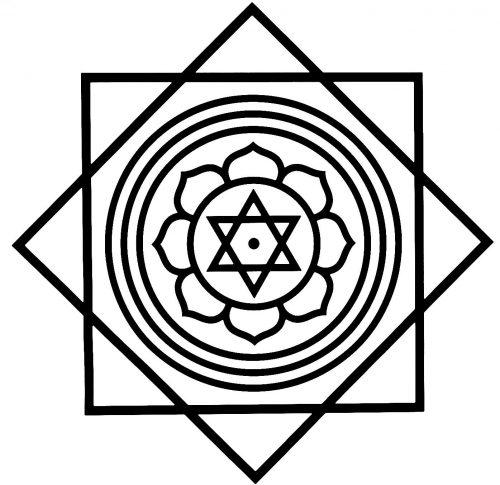Ganesha
The god with an elephant’s head
by Ioana Caragheorgheopol
The word “Ganesha” is formed by the words: “gana” and “isha”. “Gana” means all beings which have name and form and “isha” meaning Lord or Master. Ganesha is the name given to Shiva’s second son, because he became the master of the entire creation.
Ganesha or Ganapati is an extremely popular god in India. He is invoked in order to remove obstacles as well as in the beginning of all important actions: traveling, building a house, writing a book or even a letter, to obtain paranormal powers and the capacity of discrimination. He is the god of education, knowledge and wisdom, literature and the fine arts. All spiritual rituals in the Hindu tradition start with the invocation of Ganesha. In the tantric tradition, it is considered that Ganesha protects and guides sexual relationships, orientating them in a spiritual direction. He is regarded as being the embodiment of tantric mysteries.
Symbolic representation

Ganesha is depicted small in stature, with a large, round abdomen, with four arms and the head of an elephant with a single tusk. In three of his hands he is holds an axe (ankush), a noose (sash) and sometimes a seashell. In some representations, with the fourth hand, he makes a gesture granting his divine favour, but more often he is holding a ladhu, a chickpea cookie. His eyes shine like two precious stones. He is riding or is accompanied by a rat, a former demon which he defeated and then accepted as his vehicle.
This representation may not be very attractive for the rational mind. His animal head and fat body attract children but for those who consider themselves to be adults, he seems ridiculous. It is a mistake however to deceive ourselves by his appearance, because Ganesha is the patron of refined beings who are not deceived by outer appearances. However those who cannot see the Divine in him and are distracted by his representation, become pray for the discursive mind, which represents the greatest obstacle on the spiritual path. Accepting Ganesha as a Divine Force has the effect of controlling and calming the mind as well as in dissipating doubts. This is why he is considered to be the most suitable deity for removing obstacles. Believing in him generates a huge force, reversing the usual downward flow of energy, orientating it upwards and thus allowing the activation of the superior centers of force in our being. The divine Ganesha is unbreakable. He grants firmness to those who meditate upon him and invoke him at the beginning of all profane or spiritual actions.
In Mugdala Purana it is said: “Ganesha’s human body represents «tvam» (you), the elephant’s head is «tat» (Brahman) and together they signify the unity between these two aspects. Therefore Ganesha’s body is the visible representation of the highest reality, Brahman, expressed by «tat tvam asi» (you are That (Brahman or God)).”
Another explanation is that, generally, Ganesha’s head represents Atman, the Supreme Reality while his body, from the neck down, symbolizes maya, the principle of phenomenal existence. The involvement of Atman in the world is realised through mind and speech.
Legends about the elephant head
There are of course many esoteric explanations regarding the elephant head. An elephant is strong, but always calm. It is one of the few animals conscious of itself and which even has funerary rituals. Despite its force, it is vegetarian.
Puranas offer many versions with regard to Ganesha’s birth and origins of his elephant head. In Shiva Purana it is told that he was created out of an ointment for washing(ubtan) which Parvati, the Divine Mother, took from her body. It is said that one day, as Parvati was preparing to take a bath, she became aware that the guardian of her apartments was missing. She then took a part of the soap from her body, molded it into the shape of a child and blew vital force, prana, onto it. She charged this child to be her guardian and instructed him not to allow anyone to enter the palace. The child-guard respected his mother’s words and sat outside, with the scepter in his hand. Exactly then, Shiva chose to visit his beloved wife, Parvati, and he came to the palace. Because the little guard prevented him from entering, Shiva got angry and threatened the boy but he was unflinching and only with the support of demons and gods together he could be defeated. Shiva became so furious, that he cut off the boy’s head with his trident. When the Divine Mother discovered what had happened she was very sad and asked Shiva to bring him back to life. Shiva started to search for the first child sleeping orientated towards the north in order to cut his head off and place on the lifeless body. It was night and all the mothers were sleeping holding the children tight in their arms and therefore Shiva could not take the head of any child. However he saw an elephant calf sleeping alongside its mother, back to back, and decided to take advantage of this opportunity. Therefore he took the head of the elephant calf and joined it to the guardian child’s body, thus bringing him back to life. Shiva named the boy Ganapati, leader of his troops and decided that every man should adore him before conducting any major action.

Another version states that Ganesha was born as a favor granted to Parvati, following her prayers to Vishnu. The Divine Mother then invited all gods and demigods to come visit her child. They came looking to the child full of concern – all of them except for Shani (Saturn), who looked into the ground because he had been cursed by his wife that any being that looked upon would be transformed into ashes. The Divine Mother was convinced, however, that her baby could not be harmed by Shani’s eyes and despite the curse and she beseeched him again to look at the child and bless him. The moment that Shani looked at the baby, he head turned into ashes. Vishnu flew away riding Garuda (the god with an eagle’s head, his traditional vehicle), searching for a child in order to bring its head, according to Brahma’s indications. The head he found was that of an elephant calf.
There are many other stories from various ages (kalpas), regarding Ganesha’s birth but they all reveal the fact that he is a creation of the Divine Force, either Shiva or Shakti. Ganesha was created in order to guard the Divine Mother’s palace. So he is the only one that can allow us to get to Her.
Symbolism of the trunk and tusk
The trunk is a novel instrument. With its help, Ganesha removes the obstacles from the path of the aspirant. Its orientation towards the left, the right or centre is symbolic in connection with the three principle subtle energetic channels: Ida Nadi, Pingala Nadi and, respectively, Sushumna Nadi. When it is raised to the sky, it signifies the ascension and stability of Kundalini at the level of Sahashrara. In the tantra tradition, the trunk and sensuous mouth of the elephant are connected to the masculine and feminine sexual organs.
There are several legends in connection with Ganesha’s single tusk. One of them says that the other tusk was broken when Ganesha killed the demon of pride (Madasura). Another one claims that it was broken in order to be used writing the Maha-bharata. Ganesha’s tusk is a symbol of Unity.
Triumphing upon lower passions
Ganesha’s ears, resembling fans also hold a philosophical significance. Such as how fanning separates the chaff from the wheat, they symbolize the power of discrimination between the Ultimate Reality (Brahman) and the world of illusory phenomena (maya).
In regard to the rat from Ganesha’s traditional representations, it is said that it was originally the demon of vanity and impertinence and it was defeated by the god. Actually the Hindu tradition has many legends regarding the various demons chased away or defeated by Ganesha. Therefore by invoking him, the human being can thus triumph over inferior tendencies: pride, vanity, egotism, anger, arrogance, etc.
Ganesha bears the cosmic Egg in his belly
There is also a legend in connection with Ganesha’s prominent abdomen. It is said that the God of riches (Kubera) once invited the divine couple Shiva and Shakti to dinner in order to boast about his prosperity. They refused Kubera’s invitation, suggesting instead that he should feed their son, Ganesha. Kubera laughed saying: “I can feed many children like this one!” Ganesha sat calmly at the table and started to eat. First he ate all the food and then started eating the furniture, the palace, etc. Kubera was terrified but Ganesha told him cheerfully: “You promised my parents you would feed me. Now I will have to eat you, too.” Kubera ran away and asked for Shiva’s help. He gave him a handful of rice telling him to humbly offer it to Ganesha. Kubera returned. Meanwhile Ganesha’s stomach had become gigantic but he was still in a good mood. When Kubera humbly offered him a bowl of rice his hunger was finally appeased.
Ganesha is also considered to be depicted in this manner because he bears Brahmanda (the cosmic egg) in his belly.
The patron of the Ganas (beings)

There is a very meaningful story which reveals the way in which this god became the patron of the ganas thus acquiring the title of “Ganesha”.
In the ancient times, Shiva was the single master of all gods, demigods, humans, demons, phantoms, spirits and all other existing beings. But because he was in continuous divine ecstasy (samadhi), it was highly difficult for gods and for the other beings to communicate with him. Whenever they had problems, they had to spend hours singing hymns, praising and praying for Shiva to regain normal state of consciousness. This is why the ganas felt like they needed another leader, who was easier to appeal to. to resolve their problems and protect them in times of need.
They came to Brahma with this issue but he could not resolve it, so he asked for Vishnu’s help in order to convince Shiva to establish a new Ganapati (leader of the ganas). Vishnu suggested they should choose from one of Shiva’s two sons: Kartikeya (also known as Subramaniyam) or Lambodar (Ganesha the fat). In order to find out which of the two deserved the title of Ganesha, all the gods and demi-gods chose to organise a contest. On the set day, they all came witness the contest, where Vishnu was the judge. Shiva and Parvati were also present, seated in the middle. At the established moment, Vishnu announced the test of the competition. The two competitors had to go around the Universe and the one who would arrive first was to receive the title of Ganesha, master of all ganas.
After the announcement of the test, Kartikeya flew away into space, riding his extremely fast peacock, in order to go around the Universe as quickly as possible. Meanwhile Ganesha remained seated on his rat, without moving from his place. Vishnu, seeing him standing still, told him to hurry. At Vishnu’s insistence that he should begin the contest immediately, Ganesha smiled and paid homage at the feet of his father and mother, then he humbly saluted all the other gods and demigods, flying away on his rat. They were all astonished when they saw that instead of riding towards cosmic space, Ganesha flew around Shiva and Parvati. After he rode around Shiva and Shakti, Ganesha returned to the starting point, kneeled before his parents and said: “My task is complete. I have gone round the whole universe.” “No, you did not!” the gods and demigods exclaimed. “You did not go anywhere. You are lazy”
Ganesha then addressed Vishnu, his hands in a gesture of prayer: “I know you understand the significance of my actions, but in order for the others to understand me as well, I shall say the following. I have completed my task of going round the Universe because all this world of phenomena, names and shapes is nothing other than a manifestation of my Divine Mother and my Divine Father. They are the source of all what exists. I went to the source, which is the Truth, the essence of the whole existence and all phenomena. I know this world is an ocean of relative existence, that it is an illusion that has no sense to renounce the Ultimate Truth in order to go around illusion. My brother is still circling this Universe. When he arrives at the Truth, it will be the same Truth that is Unique and in relation to which all is an illusion, including you and me.”
This statement offered a glimpse of genuine understanding to his listeners who were both astonished and delighted at his wisdom. Applauding his refined judgment and enlightening action, they accepted fat Ganesha as their patron. While Vishnu marked Ganesha’s elephant forehead with the sign of victory (tilak), Kartikeya returned, tired, from his voyage around the world. He got upset and argued against Ganesha’s victory. The gods then told Kartikeya about his subtlety and wisdom and also said the following: “You went towards matter, which is illusory. You went around the phenomenal world, whose existence is relative and this is why you could not directly perceive the Ultimate Truth. It is the source. The world of phenomena is maya (illusion).” Kartikeya realized he had been fooled by maya and that his rush into the ever changing world of phenomena was in vain. Therefore all his efforts had been pointless for having chased a mirage. Kartikeya had behaved like all the other mortals who take the world of names and shapes for the actual reality, thus being trapped by maya. He accepted his defeat and the one whose wisdom had gone beyond material existence was offered the title of “Ganesha”.
Then Vishnu also decided that from that moment on, all beings should beg for Ganesha’s grace in the beginning of all their actions. Those who invoke him this way shall face no obstacles when accomplishing their beneficent goals and their path will be easy and without difficulties.
Yantra of Ganesha

Meditating and focusing upon Ganesha’s yantra grants a state of inner balance.
Its background is vivid green. Green is a blend between warm yellow and cold blue; therefore it is color of balance. Focusing upon it generates its complementary color, red. Red is a color that can be easily noticed from a distance, being the symbol of life and inspiration, of revolutions and of the release from rules and restrictions.
The eight petal lotus stands for the eight aspects of Prakriti (the primordial nature): 1. ether, 2. air, 3. fire, 4. water, 5. earth, 6. sattva, 7. rajas, 9. tamas.
The six pointed star that is the color of saffron symbolizes the balance between the masculine and feminine energy generated by the overlapping between the masculine triangle with the apex pointed upwards and the feminine triangle with the apex pointed downwards.
The yellow triangle pointed upwards, where the 6 pointed star is depicted, stands for the masculine sap (the vital essence), the elixir of immortality. The color of this triangle is the same as Ganesha’s skin.
Bindu, the point located in the middle of the central triangle represents Ganesha himself. Meditation upon this bindu is the main goal for which the yantra is worshipped. Its color is golden yellow, a color that is appealing and relaxing at the same time.
Article from Yoga Magazin magazine, issue no. 23
yogaesoteric


